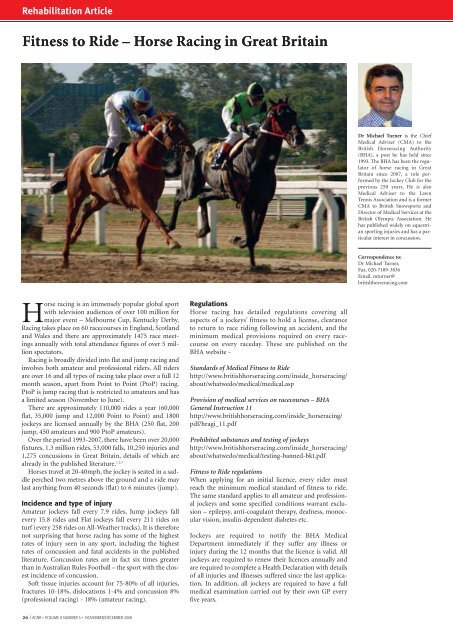Unn Ljøstad and Åse Mygland Jone Furlund Owe and Nils ... - ACNR
Unn Ljøstad and Åse Mygland Jone Furlund Owe and Nils ... - ACNR
Unn Ljøstad and Åse Mygland Jone Furlund Owe and Nils ... - ACNR
Create successful ePaper yourself
Turn your PDF publications into a flip-book with our unique Google optimized e-Paper software.
Rehabilitation Article<br />
Fitness to Ride – Horse Racing in Great Britain<br />
Dr Michael Turner is the Chief<br />
Medical Adviser (CMA) to the<br />
British Horseracing Authority<br />
(BHA), a post he has held since<br />
1993. The BHA has been the regulator<br />
of horse racing in Great<br />
Britain since 2007, a role performed<br />
by the Jockey Club for the<br />
previous 250 years. He is also<br />
Medical Adviser to the Lawn<br />
Tennis Association <strong>and</strong> is a former<br />
CMA to British Snowsports <strong>and</strong><br />
Director of Medical Services at the<br />
British Olympic Association. He<br />
has published widely on equestrian<br />
sporting injuries <strong>and</strong> has a particular<br />
interest in concussion.<br />
Correspondence to:<br />
Dr Michael Turner,<br />
Fax. 020-7189-3836<br />
Email. mturner@<br />
britishhorseracing.com<br />
Horse racing is an immensely popular global sport<br />
with television audiences of over 100 million for<br />
major event – Melbourne Cup, Kentucky Derby.<br />
Racing takes place on 60 racecourses in Engl<strong>and</strong>, Scotl<strong>and</strong><br />
<strong>and</strong> Wales <strong>and</strong> there are approximately 1475 race meetings<br />
annually with total attendance figures of over 5 million<br />
spectators.<br />
Racing is broadly divided into flat <strong>and</strong> jump racing <strong>and</strong><br />
involves both amateur <strong>and</strong> professional riders. All riders<br />
are over 16 <strong>and</strong> all types of racing take place over a full 12<br />
month season, apart from Point to Point (PtoP) racing.<br />
PtoP is jump racing that is restricted to amateurs <strong>and</strong> has<br />
a limited season (November to June).<br />
There are approximately 110,000 rides a year (60,000<br />
flat, 35,000 jump <strong>and</strong> 12,000 Point to Point) <strong>and</strong> 1800<br />
jockeys are licensed annually by the BHA (250 flat, 200<br />
jump, 450 amateurs <strong>and</strong> 900 PtoP amateurs).<br />
Over the period 1993-2007, there have been over 20,000<br />
fixtures, 1.3 million rides, 53,000 falls, 10,250 injuries <strong>and</strong><br />
1,275 concussions in Great Britain, details of which are<br />
already in the published literature. 1,2,3<br />
Horses travel at 20-40mph, the jockey is seated in a saddle<br />
perched two metres above the ground <strong>and</strong> a ride may<br />
last anything from 40 seconds (flat) to 6 minutes (jump).<br />
Incidence <strong>and</strong> type of injury<br />
Amateur jockeys fall every 7.9 rides, Jump jockeys fall<br />
every 15.8 rides <strong>and</strong> Flat jockeys fall every 211 rides on<br />
turf (every 258 rides on All-Weather tracks). It is therefore<br />
not surprising that horse racing has some of the highest<br />
rates of injury seen in any sport, including the highest<br />
rates of concussion <strong>and</strong> fatal accidents in the published<br />
literature. Concussion rates are in fact six times greater<br />
than in Australian Rules Football – the sport with the closest<br />
incidence of concussion.<br />
Soft tissue injuries account for 75-80% of all injuries,<br />
fractures 10-18%, dislocations 1-4% <strong>and</strong> concussion 8%<br />
(professional racing) - 18% (amateur racing).<br />
Regulations<br />
Horse racing has detailed regulations covering all<br />
aspects of a jockeys’ fitness to hold a license, clearance<br />
to return to race riding following an accident, <strong>and</strong> the<br />
minimum medical provisions required on every racecourse<br />
on every raceday. These are published on the<br />
BHA website -<br />
St<strong>and</strong>ards of Medical Fitness to Ride<br />
http://www.britishhorseracing.com/inside_horseracing/<br />
about/whatwedo/medical/medical.asp<br />
Provision of medical services on racecourses – BHA<br />
General Instruction 11<br />
http://www.britishhorseracing.com/inside_horseracing/<br />
pdf/hragi_11.pdf<br />
Prohibited substances <strong>and</strong> testing of jockeys<br />
http://www.britishhorseracing.com/inside_horseracing/<br />
about/whatwedo/medical/testing-banned-bkt.pdf<br />
Fitness to Ride regulations<br />
When applying for an initial licence, every rider must<br />
reach the minimum medical st<strong>and</strong>ard of fitness to ride.<br />
The same st<strong>and</strong>ard applies to all amateur <strong>and</strong> professional<br />
jockeys <strong>and</strong> some specified conditions warrant exclusion<br />
– epilepsy, anti-coagulant therapy, deafness, monocular<br />
vision, insulin-dependent diabetes etc.<br />
Jockeys are required to notify the BHA Medical<br />
Department immediately if they suffer any illness or<br />
injury during the 12 months that the licence is valid. All<br />
jockeys are required to renew their licences annually <strong>and</strong><br />
are required to complete a Health Declaration with details<br />
of all injuries <strong>and</strong> illnesses suffered since the last application.<br />
In addition, all jockeys are required to have a full<br />
medical examination carried out by their own GP every<br />
five years.<br />
20 I <strong>ACNR</strong> • VOLUME 8 NUMBER 5 • NOVEMBER/DECEMBER 2008

















